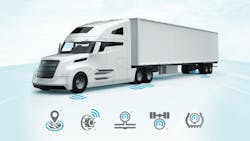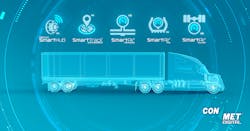Ask the Expert: What maintenance providers should know about smart trailers
Connected trailers are here, offering fleets more sensors, data, and insights to operate more efficiently. Here’s what fleets should now about them.
What makes a trailer connected?
Simply put, the internet allows for a connected trailer to be possible. However, the process is a bit more involved. A trailer becomes connected with the installation of a communications gateway and sensors. The gateway is the foundation for all telematics systems and can be retrofit onto existing trailers. Similarly, sensors can be added to specific trailer components, like SmartAir TPMS pass-through valve stem sensors that thread right onto existing tire valve stems, or integrated into existing equipment for ease of installation, like the PreSet Plus SmartHub wheel hub assemblies.
Once installed, the telematics gateway receives data from one or more sensors across the trailer and then transmits that data via a cellular network to a cloud database. The data is then processed and analyzed by a telematics vendor and connected via the internet to secure online dashboards or mobile apps. The fleet’s back office and drivers can see actionable insights and make decisions based on the same data.
The sensors offered by ConMet Digital are Bluetooth Low Energy 5 capable, the latest wireless communication standard that brings a greater range, lower power consumption and higher data throughput. On a trailer, the gateway enables various sensors to communicate wirelessly, streamlining installation and service. Utilizing the same technology on tractors ties assets together and gives fleets visibility into all their assets on the road. ConMet Digital provides a single online dashboard for easy access to insights and we are currently working on a new driver-based app that will provide insights to drivers in real-time for better coordinated efforts across all fleet operations to keep vehicles rolling down the road.
Read more: ConMet eHub to power zero-emission reefer trailer
How soon are they coming and why should I care?
Connected trailers are already here! Now, it’s about realizing the value of the investment.
Hardware and basic data feeds have been around for years now. In fact, there has been quite a bit of talk over the last five years as more companies get involved and more services become available. Early fleet adopters who were eager to install systems from a few years ago continue to struggle making sense of the amount of raw data and multiple dashboards they have to use to make older systems work for them. At ConMet Digital, our current offerings to the market bring fleets actionable information without the distraction of raw data spreadsheets or multiple log-ins.
Today, companies like ConMet Digital are also turning the corner with advanced data analytics and streamlined data feeds. Fleets want to know what to do and when to do it based on expert advice, and they want a one-stop shop where they can see alerts across their fleet. ConMet Digital’s offering combines data from multiple sensors and analyzes for trends across a single asset, the fleet, and other similar assets on the road. A set of proprietary algorithms translate the bulk data into more actionable insights that fleets can use. This allows fleet maintenance managers and drivers to take immediate action to correct or repair specific components on a trailer or tractor to keep it running or alleviate issues before an asset leaves the yard. ConMet Digital has also created a suite of application programming interfaces (APIs) that allow these insights to easily appear in any existing telematics dashboard a fleet may already be using. These integrated solutions better accommodate existing fleet operations and provide a faster return on investment.
Convenient telematics that can be retrofit on existing assets are becoming more valuable as fleets extend the life of their trailers due to production backlogs. Telematics can automate pre-trip inspections and driver vehicle inspection reports (DVIRs). Plus, the data provided by these systems allows technicians and drivers to correct tire pressure, monitor air line connections, or maximize a load before hitting the road. More detailed knowledge of asset wear and tear can help fleets make the most of their preventative maintenance, increasing uptime. For example, a SmartHub sensor can detect the early warning signs of abnormal hub bearing wear allowing a fleet to perform a more detailed inspection or repair of a single hub before failure occurs and puts that asset out of operation.
ConMet Digital currently offers SmartHub wheel end monitoring, SmartAir TPMS, SmartTrack asset management, SmartAir line pressure monitoring, and SmartAir axle load monitoring.
What metrics should I look at to see if it’s the right investment for me?
Fleets should turn to the metrics they already use to optimize total cost of ownership.
- If reducing tire costs is a priority, fleets should pursue telematics options that can lend to reducing these tire maintenance costs, like TPMS and SmartHub wheel end monitoring. Using data from these specific systems can help fleets improve fuel economy by maintaining more constant tire pressure, reducing overall tire repair or replacement costs by focusing tire maintenance in-house and avoiding roadside repairs and reducing expensive labor costs.
- For fleets looking to improve asset utilization, SmartTrack asset management can save valuable time locating assets with detailed GPS information and establish customized geofence alerts to monitor assets at a specific location.
- To reduce inspection violations and fines, fleets can also turn to telematics like TPMS and axle load monitoring that allow drivers or yard operators to correct tire pressure and trailer loads before hitting the road to reduce returns to the yard and route delays.
How will this impact maintenance?
When telematics systems are set up to provide fleets simple, effective alerts through a streamlined dashboard or app, it can enable maintenance staff and drivers to be more proactive and efficient. Knowing the health of key systems on an asset puts decision-making power in the hands of fleet operations employees. They can spend less time locating assets and manually checking every component pre-trip and more time where corrective action is necessary to increase safety and uptime. Good telematics systems can enable more efficient asset utilization, remote yard checks, and pre-trip repairs or corrections. Altogether, fleets can leverage telematics systems to streamline workflows and spend less time on healthy assets.
What type of new tools and training will my shop technicians need?
Incorporating telematics systems into a fleet’s daily operations can vary, depending upon the system chosen and the fleet’s current operating procedures.
Some systems may require detailed instruction on how to interpret data, troubleshoot and pair sensors, or learn to operate custom displays and smart devices. This can take weeks to months for technicians to incorporate into existing workflows and can make the use of telematics seem more difficult than they need to be.
With ConMet Digital’s system, the learning curve is quite a bit smaller. The simplified hardware design ensures all the sensors communicate using the same technology. This means fewer parts to install, manage, and troubleshoot. We also use Bluetooth, a highly efficient wireless communication that uses less energy to capture sensor data and push data to the gateway. This efficiency extends the life of our sensor batteries so that our sensors last in operation for up to five years before needing to be replaced.
By using data analytics, we do the data processing, so technicians receive alerts that are actionable and easy to understand. For a quick start, the data is accessible from any existing smart device that technicians may already use. The interface is easy to understand and focuses attention on alerts across all outfitted fleet assets on a simple home page. Our data feed can also integrate easily into existing dashboards the technicians may already be using to monitor asset health, including those available from our telematics partners. So, this flexibility offers fleets a lot of options to make integration fast and effective.
About the Author

Isaac Otto
Isaac Otto is the Product Manager for ConMet's digital business unit. He joined ConMet in 2020, bringing his experience developing IoT products for the trucking industry over the last five years. In his previous roles at Daimler Trucks NA, he led analytics projects and managed advanced products within Digital Vehicle Solutions group. His work helped grow fleet-focused services from a single core offering to a robust ecosystem of IoT products. He has a bachelor’s degree in Political Science and an MBA in Operations Technology Management from the University of Portland.


